Highlight The Bastogne war Museum
We had a basic breakfast at the hotel and headed for Le Quesnoy.
I had finally learned how to pronounce it properly as ‘Le Ken Wah’ but our GPS
never learned and we had the wrong pronunciation all the way. We were first on
some nice country roads but then on a highway.
We knew there was not much to the town, but John has been keen
to visit for a while and it didn’t work out last trip. I made it work this
time.
“Le Quesnoy was freed by NZ troops from their 3rd
Division, near the end of WWI. The town has been forever grateful, because
instead of shelling the town beforehand and inflicting a lot of potential
damage, the troops scaled the high city walls by ladders and defeated the
German troops within, causing minimal damage and suffering only minor
casualties.” - JB
We parked on the side of the road and walked following the NZ
memorial signs to the right area. We could in fact have parked closer but a walk
after the drive was good for us. We found the memorial on the outside of the
original walls, and also some plaques. It was a peaceful area with only a man
from the local council and ourselves along with a couple of walkers.
We thought we could have got down from the memorial to the
bottom of the wall, but the route seemed more of an unofficial track and a bit
steep so we wandered towards a cache instead. When we found it was in fact on
the other side of a swamp area we headed back and towards the township. We had
a salad lunch and ended up talking to 2 other New Zealander’s who were staying
in Lille and had bussed here to see the memorial also.
We walked around the town a little with a viewpoint and cache in
mind but we found only the view. The cache site was of interest though as it
took us to the only bridge, Porte Faulroeux, that had not been
damaged in WW2. We also saw a very random model of a Maori warrior. There were
also lots of signs in shops welcoming “our friends from New Zealand”.
Our next destination was the Bastogne War Museum. We knew this
was going to make it a longish driving day but again John was very keen to
visit this. Also we could not book in to our room until after 6pm and the
museum was open until 7pm so it fitted in well. They close the doors at 5pm as
they believe you need 2 hours at least here and we were close to that amount of
time.
John knew a lot about “the Battle of the Bulge”, and how “the
brawling bastards of Bastogne” stopped the German momentum, and turned the tide
of the battle. I also knew a little of the history. That may have helped, as we
could just focus on the method of presentation which we found excellent. We
were given audio guides that automatically sensed where we were and gave the
appropriate commentary. The displays were also good but the best parts were the
3 AV presentations.
The presentations were based on following a Belgian boy of 13,
his former teacher who had been in the Resistance, a 20-year-old who was in the
US Airborne division and a young German officer. Prior to the first display we
were ‘introduced’ to them all, and also saw other displays of war memorabilia.
We then entered a cinema and put on 3D glasses. The film was
more about Operation Overlord, in line with the scene setting. It was well done
and had extra significance as we had so recently been in Normandy. The German officer’s
role in Monte Casino and the Russian front also featured, as well as the story
of Rommel in Africa.
The second presentation was totally different. The room we were
in represented a forest scene and was deliberately made cold. It covered the
events near Christmas 1944 and showed the boy biking into Bastogne to hide in
his uncle’s cellar, the teacher going in as it had been known she was in the
Resistance and the Germans were approaching and our US airman fighting from a
foxhole in the 15 below temperature with limited food and ammunition. It
finished with airdrops and the German officer being taken prisoner.
The last presentation was at the café. We saw the US soldiers in
the streets then above an empty café, the top lifted, and we were in the
cellar. This part had the boy playing his ukulele, food being cooked in the
cellar by the teacher and other adults, and the US officer and his prisoner
coming in. It showed the German officer being fed and his wounds treated while
the bombing went on overhead.
At the end we were told the boy’s parents had been killed that
night, but the teacher’s parents had escaped into the fields from their farm,
and survived. The message was made again afterwards about the pointlessness of
war. It ended with the boy biking off to visit the seaside, a trip his father
had always promised to do with him.
Outside we headed for the huge sculpture of the US airman
hugging a woman and could only agree with the US visitor that it was hard to
find the best angle to photograph it. We didn’t go into the other US Memorial
(Mardasson Memorial), but did see it from a short distance, as we were watching
the time, having said we would arrive at about 6.30pm.
We then drove around to meet Natalie. We were booked into a room
in her house with a shared bathroom but I had decided that would be fine. We
asked for a suggestion of a place to eat that we were able to walk to and spent
part of the time planning the next day and part discussing how well done the
museum had been.
We ended up having a nice meal in town and enjoyed the many
sculptures we saw. We were also intrigued by one street that was completely
covered with colourful open umbrellas that were strung above.

 Bastogne, Walloon Region, Belgium
Bastogne, Walloon Region, Belgium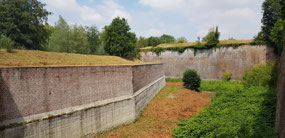
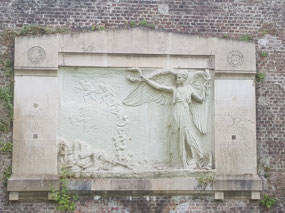
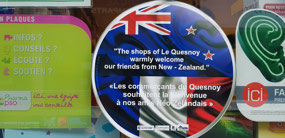
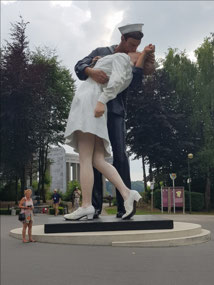
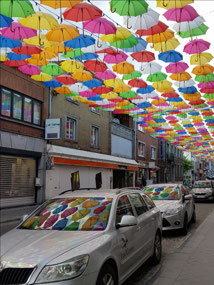










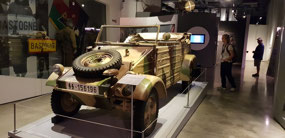
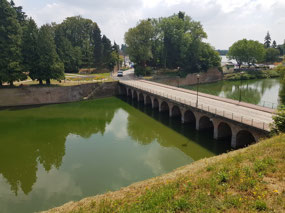
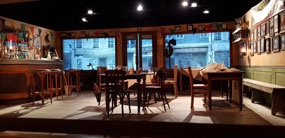
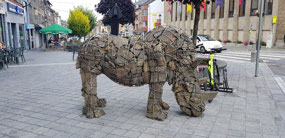
2025-05-22